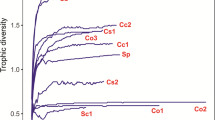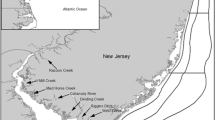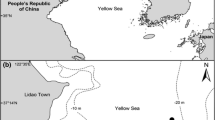Abstract
The dietary compositions of the co-occurring gerreid Parequula melbournensis and the carangid Pseudocaranx wrighti have been determined, using samples collected seasonally from a 200 km stretch of coastal water in temperate Australia, in which these species are very abundant. Although the small representatives of P. melbournensis and P. wrighti both fed to a large extent on copepods, the latter ingested a wider variety of prey and thus had a greater dietary breadth. The diets of both species changed markedly as body size increased. The larger representatives of P. melbournensis fed mainly on onuphid and other polychaetes, whereas those of P. wrighti consumed a considerable volume of crustaceans, molluscs, polychaetes other than onuphids, and echinoderms. The above differences account for the dietary breadth being far greater in large P. wrighti than large P. melbournensis. Schoener's index and classification showed that dietary overlap between P. melbournensis and P. wrighti was low, suggesting that food resources were partitioned between these two demersal species. Intraspecific overlap was less amongst the length classes of small fish than among those of larger fish, indicating that any competition for food would be less among small fish, when growth would have been most rapid. The larger P. melbournensis fed mainly on prey types which were relatively sessile and can protrude from the substrate, such as tube-dwelling onuphid polychaetes, whereas the larger P. wrighti fed on a variety of epibenthic and/or more mobile species, such as mysids, amphipods, bivalves, gastropods, nereid polychaetes and echinoderms. Although P. melbournensis foraged to a far greater extent on a sessile fauna that occurs on or in the substrate, it ingested a far smaller amount of sand than P. wrighti, even though this latter species fed on a more epibenthic fauna. The presence of smaller amounts of sand in the stomach contents of P. melbournensis than of P. wrighti, presumably reflects the possession of a smaller and far more protrusible mouth, which enabled its sessile prey to be targetted more precisely. The dietary composition of P. melbournensis and P. wrighti underwent some seasonal changes, presumably reflecting seasonal fluctuations in the densities of prey species, and that of P. melbournensis differed slightly between some sites.
Similar content being viewed by others

References cited
Austin, H.M. 1971. Some aspects of the biology of the rhomboid mojarra Diapterus rhombeus in Puerto Rico. Bull. Mar. Sci. 21: 886–903.
Blaber, S.J.M., D.T. Brewer & J.P. Salini. 1994. Diet and dentition in tropical ariid catfishes from Australia. Env. Biol. Fish. 40: 159–174.
Blaber, S.J.M. & D.P. Cyrus. 1983. The biology of Carangidae (Teleostei) in Natal estuaries. J. Fish Biol. 22: 173–188.
Brewer, D.T., S.J.M. Blaber, D.A. Milton & J.P. Salini. 1994. Aspects of the biology of Caranx bucculentus (Teleostei: Carangidae) from the Gulf of Carpentaria, Australia. Aust. J. Mar. Freshw. Res. 45: 413–427.
Brewer, D.T., S.J.M. Blaber & J.P. Salini. 1989. Feeding biology of Caranx bucculentus Alleyne and Macleay (Teleostei: Carangidae) in Albatross Bay, Gulf of Carpentaria, with special reference to predation on penaeid prawns. Aust. J. Mar. Freshw. Res. 40: 657–668.
Carr, W.E.S. & C.A. Adams. 1973. Food habits of juvenile marine fishes occupying seagrass beds in the estuarine zone near Crystal River, Florida. Trans. Amer. Fish. Soc. 3: 511–540.
Clarke, K.R. 1993. Non-parametric multivariate analyses of changes in community structure. Aust. J. Ecol. 18: 117–143.
Clarke, K.R. & R.M. Warwick. 1994. Change in marine communities: an approach to statistical analysis and interpretations. Plymouth Marine Laboratories, Plymouth. 137 pp.
Cunningham, P.T.M. & E.O. de Camargo. 1995. Diel cycle and ontogenetic feeding variation aspects of Eucinostomus gula (Cuvier, 1930) and Eucinostomus melanopterus (Bleeker, 1863) (Gerreidae), in the Lagoa da Conçeicão (SC), southern Brazil. Arquivos de Biologia e Tecnologia 38: 235–248.
Cyrus, D.P. & S.J.M. Blaber. 1982. Mouthpart structure and function and the feeding mechanisms of Gerres (Teleostei). S. Afr. J. Zool. 17: 117–121.
Cyrus, D.P. & S.J.M. Blaber. 1983a. The food and feeding ecology of Gerreidae, Bleeker 1859, in the estuaries of Natal. J. Fish Biol. 22: 373–393.
Cyrus, D.P. & S.J.M. Blaber. 1983b. Diet of Gerres fry in the Kosi system. S. Afr. J. Zool. 18: 403–406.
Cyrus, D.P. & S.J.M. Blaber. 1984. The feeding ecology of Gerreidae (Teleostei) in the Kosi system, with special reference to their seasonal diet. Lammergeyer 32: 35–49.
Fauchald, K. 1977. The polychaete worms: definitions and keys to the orders, families and genera. Allan Hancock Foundation, University of southern California, Los Angeles. 188 pp.
Field, J.G., K.R. Clarke & R.M. Warwick. 1982. A practical strategy for analysing multispecies distribution patterns. Mar. Ecol. Prog. Ser. 8: 37–52.
Gibson, R.N. & I.A. Ezzi. 1987. Feeding relationships of a demersal fish assemblage on the west coast of Scotland. J. Fish Biol. 31: 55–69.
Gomon, M.F., J.C.M. Glover & R.H. Kuiter. 1994. The fishes of Australia's south coast. State Print, Adelaide. 992 pp.
Gunn, J.S. & N.E. Milward. 1985. The food, feeding habits and feeding structures of the whiting species Sillago sihama (Forsskål) and Sillago analis Whitley from Townsville, north Queensland, Australia. J. Fish Biol. 26: 411–427.
Hales, L.S. 1987. Distribution, abundance, reproduction, food habits, age, and growth of round scad, Decapterus punctatus, in the south Atlantic bight. U.S. Fish. Bull. 85: 251–268.
Hamerlynck, O. & A. Cattrijsse. 1994. The food of Pomatoschistus minutus (Pisces, Gobiidae) in Belgian coastal waters, and a comparison with the food of its potential competitor P. lozanoi. J. Fish Biol. 44: 753–771.
Harmelin-Vivien, M.L., R.A. Kaim-Malka, M. Ledoyer & S.S. Jacob-Abraham. 1989. Food partitioning among scorpaenid fishes in Mediterranean seagrass beds. J. Fish Biol. 34: 715–734.
Hutchins, B. & R. Swainston. 1986. Sea fishes of southern Australia, Swainston Publishing, Perth, Western Australia. 180 pp.
Hynes, H.B.N. 1950. The food of fresh-water sticklebacks (Gasterosteus aculeatus and Pygosteus pungitius), with a review of methods used in studies of the food of fishes. J. Anim. Ecol. 19: 36–58.
Hyslop, E.J. 1980. Stomach contents analysis — a review of methods and their application. J. Fish Biol. 17: 411–429.
Kerschner, B.A., M.S. Peterson & R.G. Gilmore. 1985. Ecotopic and ontogenetic trophic variation in mojarras (Pisces: Gerreidae). Estuaries 8: 311–322.
Kotrschal, K. 1989. Trophic ecomorphology in eastern Pacific blennioid fishes: character transformation of oral jaws and associated change of their biological roles. Env. Biol. Fish. 24: 199–218.
Kwei, E.A. 1978. Food and spawning activity of Caranx hippos (L.) off the coast of Ghana. J. Nat. Hist. 12: 195–215.
Laprise, R. & S.J.M. Blaber. 1992. Predation by Moses perch, Lutjanus russelli, and blue-spotted trevally, Caranx bucculentus, on juvenile brown tiger prawn, Penaeus esculentus: effects of habitat structure and time of day. J. Fish Biol. 40: 627–635.
Longhurst, A.R. 1957. The food of the demersal fish of a west African estuary. J. Anim. Ecol. 26: 369–387.
Lyle, J.M. 1977. A comparative study of the diet and feeding structures of some carangids trawled off Townsville, north Queensland. Honours Thesis, James Cook University, Queensland. 133 pp.
McLoughlin, P.A. 1980. Comparative morphology of recent crustacea. W.H. Freeman, San Francisco. 177 pp.
Meyer, M. & M.J. Smale. 1991. Predation patterns of demersal teleosts from the Cape south and west coasts of South Africa. 2. Benthic and epibenthic predators. S. Afr. J. Mar. Sci. 11: 409–442.
Motta, P.J. 1988. Functional morphology of the feeding apparatus often species of Pacific butterflyfishes (Perciformes, Chaetodontidae): an ecomorphological approach. Env. Biol. Fish. 22: 39–67.
Norton, S.F. 1995. A functional approach to ecomorphological patterns of feeding in cottid fishes. Env. Biol. Fish. 44: 61–78.
Pen, L.J., I.C. Potter & M.C. Calver. 1993. Comparisons of the food niches of three native and two introduced fish species in an Australian river. Env. Biol. Fish. 36: 167–182.
Pielou, E.C. 1966. Shannon's formula as a mean of species diversity: its use and misuse. Amer. Nat. 100: 463–465.
Prabhakara Rao, A.V. 1968. Observations on the food and feeding habits of Gerres oyena (Forskål) and Gerres filamentosus Cuvier from the Pulicat Lake with notes on the food of allied species. J. Mar. Biol. Ass. India 10: 332–346.
Reilly, C.A., T.W. Echeverria & S. Ralston. 1992. Interannual variation and overlap in the diets of pelagic juvenile rockfish (Genus: Sebastes) off central California. U.S. Fish. Bull. 90: 505–515.
Ross, S.T. 1986. Resource partitioning in fish assemblages: a review of field studies. Copeia 1986: 352–388.
Salini, J.P., S.J.M. Blaber & D.T. Brewer. 1994. Diets of trawled predatory fish of the Gulf of Carpentaria, Australia, with particular reference to predation on prawns. Aust. J. Mar. Freshw. Res. 45: 397–411.
Schoener, T.W. 1970. Nonsynchronous spatial overlap of lizards in patchy habitats. Ecology 51: 408–418.
Scrimgeour, G.J. & M.J. Winterbourn. 1987. Diet, food resource partitioning and feeding periodicity of two riffle-dwelling fish species in a New Zealand river. J. Fish Biol. 31: 309–324.
Sheldon, A.L. & G.K. Meffe. 1993. Multivariate analysis of feeding relationships of fishes in blackwater streams. Env. Biol. Fish. 37: 161–171.
Stergiou, K.I. & H. Fourtouni. 1991. Food habits, ontogenetic diet shift and selectivity in Zeus faber Linnaeus, 1758. J. Fish Biol. 39: 589–603.
Sudekom, A.E., J.D. Parrish, R.L. Radtke & S. Ralston. 1991. Life history and ecology of large jacks in undisturbed, shallow, oceanic communities. U.S. Fish. Bull. 89: 493–513.
Teixiera, R.L. & J.A. Musick. 1995. Trophic ecology of two congeneric pipefishes (Syngnathidae) of the lower York River, Virginia. Env. Biol. Fish. 43: 295–309.
Winemiller, K.O. & L.C. Kelso-Winemiller. 1994. Comparative ecology of the African pike, Hepsetus odoe, and tigerfish, Hydrocynus forskahlii, in the Zambezi River floodplain. J. Fish Biol. 45: 211–225.
Wöhler, O.C. & F. Sánchez. 1994. Feeding ecology of castañeta (Cheilodactylus bergr, Pisces: Cheilodactylidae) in the southwestern Atlantic (34–477S). Aust. J. Mar. Freshw. Res. 45: 507–520.
Author information
Authors and Affiliations
Rights and permissions
About this article
Cite this article
Platell, M.E., Sarre, G.A. & Potter, I.C. The diets of two co-occurring marine teleosts, Parequula melbournensis and Pseudocaranx wrighti, and their relationships to body size and mouth morphology, and the season and location of capture. Environmental Biology of Fishes 49, 361–376 (1997). https://doi.org/10.1023/A:1007388200920
Issue Date:
DOI: https://doi.org/10.1023/A:1007388200920



